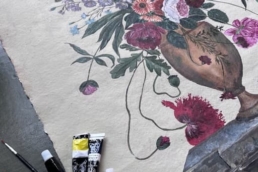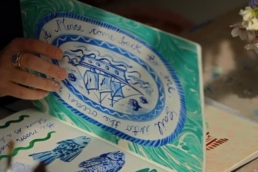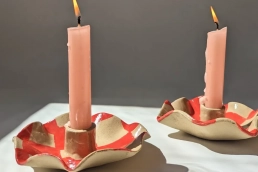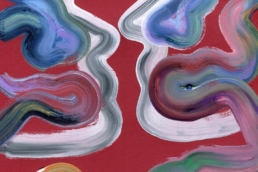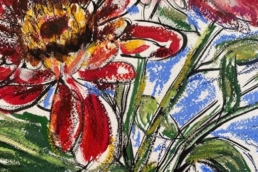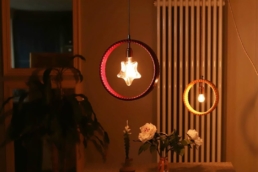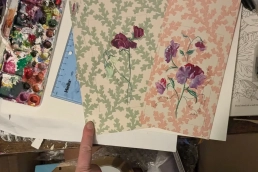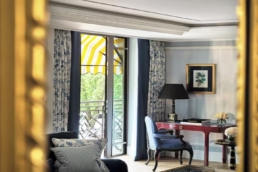In this Q&A, we speak with Joanna Ling about the quiet elegance of her ceramic practice shaped by the English countryside and a considered approach to design. Joanna Ling explores how minimalism and meaning come together in each handmade piece, drawing on the gentle forms of fields, woods, and the spaces her work is destined for.
She shares her thoughts on the beauty of one-of-a-kind objects in a world of mass production, the satisfaction of working on bespoke commissions, and the role sustainability plays in her process, from brush-on glazes to careful material reuse.
With a client list that includes Matches Fashion, the National Portrait Gallery, and The Newt in Somerset, Joanna Ling’s ceramics resonate with those who appreciate thoughtful craft and timeless design.

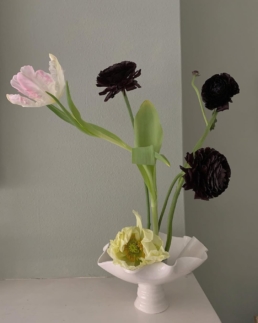
1. Can you tell us a bit about yourself and your artistic journey?
I design and make – mainly porcelain – ceramics from my garden studio. I worked at Sotheby’s for over 30 years and while I was there I did a ceramics evening class. I was immediately smitten and when I left Sotheby’s in 2018 I set up my ceramics business. It has been an incredibly rewarding journey since then!
2. What inspired you to pursue your craft? Was there a defining moment or influence that sparked your passion?
I have always been fascinated by ceramics. Soon after I started my ceramics evening class, I entered a porcelain bowl in the Sotheby’s annual staff exhibition which was, to my great surprise, bought by the chairman and other pieces were commissioned by a high level Sotheby’s client. This gave me the boost to start making ceramics commercially.
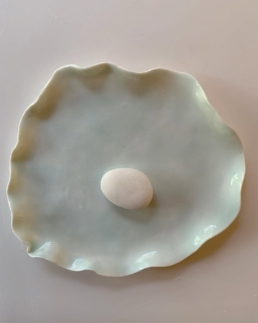
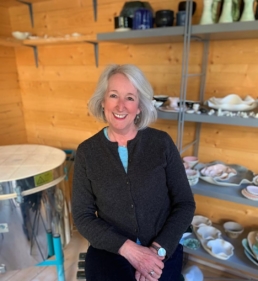
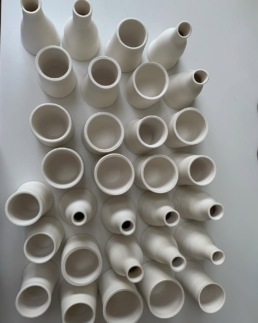
Your craft
3. How would you describe your work in three words?
Contemporary, unique, functional
4. What materials or techniques do you use, and why are they important to your process?
I work almost exclusively with porcelain because although it is a difficult clay to work with I love its delicacy and translucency once it has been fired. I normally use a transparent glaze to accentuate these qualities.
I either hand build or throw on the wheel or a combination of the two. As I make everything individually, no two pieces are the same, so when you buy from me you know that you have a unique work. In a bid for sustainability, I raw glaze my work with brush-on glazes and recycle wherever possible.
5. Can you tell us about a favourite piece you’ve created and the story behind it?
I have been making wave top pedestal bowls for many years and they are one of my most popular designs. I suddenly had an idea to make a vase version of it which I did last year and I love it because it works well with all my other designs but serves a different function, can be styled in so many ways and makes a great table centrepiece. I have now experimented with different sizes and heights so that they can be used for a single stem or an extravagant arrangement.

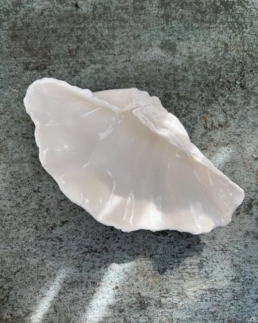
Creative process
6. What does a typical day in your studio or workshop look like?
All my days are different. Most of the time I am working on orders which means throwing on the wheel in my studio or hand building, often in my kitchen. Other days are glazing days and as with any business a lot of time is spent on admin.
Days when I open my kiln to discover how everything has come out are always exciting. If I have set off a lustre firing it is usually a joy to open to see the gold or silver highlighting the porcelain.
7. Do you have any unique rituals or habits that help you stay creative?
I always have my notebook with me should inspiration strike. My work is very much influenced by nature and I walk in Richmond Park most days and often come up with new ideas whilst there. I am an art historian by training and one of my great pleasures is visiting exhibitions and often I will see something, be it a colour, a design on a frame or ceramic piece in a painting that can lead to thoughts for new designs.
8. How do you handle creative blocks? Do you have any strategies or tips for overcoming them?
I am usually busy working on commissions which doesn’t leave me much time to work on new designs but I find when I have a quieter patch that is when I have time to think and plan and get motivated about new work. I have accepted, after several years of running a business, that work and creativity ebbs and flows and that is ok.
Challenges and successes
9. What’s the biggest challenge you’ve faced as a maker, and how did you overcome it?
The solitary nature of being a maker. Being part of Makers Made is a brilliant antidote to that. It’s great to be part of a supportive network and to be able to run ideas and problems past people who are in the same situation. I have also recently joined a couple of local artists groups which are similarly rewarding.
10. What’s been your proudest moment or achievement so far?
It’s always a thrill to be commissioned by a well known brand or establishment but I think my proudest moment was having my work stocked in the shop at The National Portrait Gallery to accompany a major Cecil Beaton show there. I ran the Beaton Archive at Sotheby’s for over 20 years and had a curatorial role in the show so to be involved with both my old and new career hats on was an amazing experience.
11. What’s your favourite quote you’ve ever heard about your work? Who said it, or what was the name of the publication?
“I instantly loved your work when I first saw it - the delicacy, subtle tones, glazes and quirky shapes.”
- Birdie Fortescue
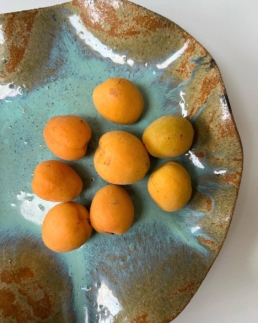
Inspiration
12. Where do you draw inspiration from for your work? What sparks your imagination and creativity?
The natural world – especially flowers and shells – and working on the Cecil Beaton archive has definitely had an influence on my work. He had such an amazing eye for design.
13. Do you have a favourite artist, maker, movement, or tradition that has influenced your craft?
The ceramics of Lucie Rie, paintings by Giorgio Morandi and the pared back aesthetics of Japan.
14. How does colour influence your practice; is it an important part of your process? Do you have a particular palette or favourites? Any go-to sources for colour inspiration?
Decoration is usually in the form of my ceramics and leaving them unglazed or with a transparent glaze brings out the inherent qualities in the porcelain clay. I sometimes use green, blue and pink glazes and love a bit of gold lustre to add a highlight to a piece.
Perspectives and goals
15. What role does your environment play in shaping your creativity?
A huge role. I am lucky enough to have my own studio in my garden. It is simple and functional but surrounded by greenery. It is a peaceful and soothing creative space.
16. What do you want people to feel when they experience your work?
That they are seeing something that is aesthetically pleasing but also functional and that they will enjoy it for a long time.
17. What are you currently working on, and what excites you most about it?
I was recently commissioned to make vases to go on each table in The Glade Bar at Sketch in London. I love making bespoke pieces for a particular place so this was perfect, particularly as it is such an amazing place!
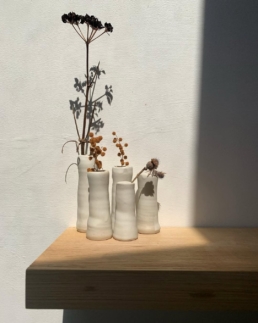
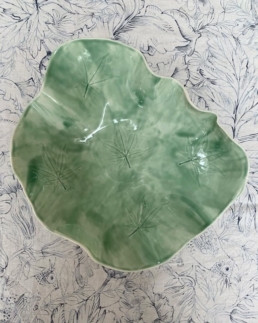
Advice and reflection
18. What advice would you give to someone starting out as a maker?
Just go for it! If it is the right thing for you it will work and give you great pleasure and satisfaction. Don’t be afraid to approach stockists or galleries you would like to work with.
19. If you could go back to the start of your career, what advice would you give your younger self?
That things work out as they should. Don’t feel you have to stay in a job if you want to start your own business. My second and fulfilling career came about after leaving a company I had worked for for over 30 years. It was scary but so worth it. Be brave.
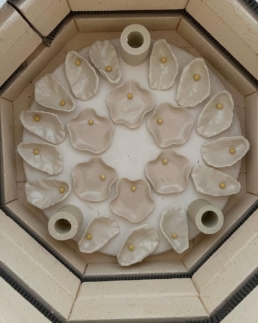
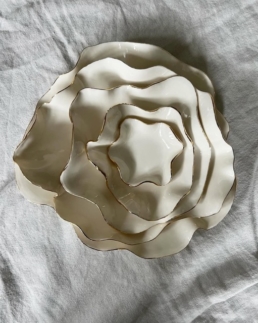
Closing thoughts
20. If you could collaborate with any artist, past or present, who would it be and why?
Lucie Rie. I would have loved to work with her in her small studio in Albion Mews and learn how she produced such beautiful work. She was so ahead of her time and her work still looks so contemporary.
21. Where can people find your work, and how can they support you?
I have various UK stockists including The Muse at Estelle Manor, The Newt in Somerset, Thyme England and Glassette amongst others. You can also buy direct from me by contacting me through my website or through my Instagram account. I have an Open Studio in May and November each year where new work, seconds and samples are for sale.
Visitors are also welcome to my studio at other times, by appointment. It’s always lovely when people see where the work is made and can find one-off pieces that aren’t usually available.
Joanna Ling’s ceramics blend restraint, story, and intention, each piece echoing both the English countryside and the person or space it’s made for. In a fast-paced world, her practice offers a slower, more meaningful way of making, where uniqueness is celebrated and connection is at the heart of every commission.
Explore Joanna’s collections and find out more about her studio practice:
Support Joanna by visiting her website, exploring her delightful creations, and connecting with her vibrant community on Instagram.


